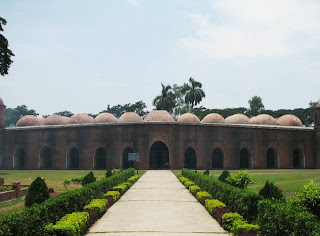 |
| Shat Gambuj Mosque |
In mid-15th century, a Muslim colony was founded in the unfriendly mangrove forest of the Sundarbans near the coastline in the Bagerhat district by an obscure saint-General, named Ulugh Khan Jahan. He was the earliest torch bearer of Islam in the South who laid the center of an affluent city during the reign of Sultan Nasiruddin Mahmud Shah, then known as 'Khalifalabad'.Khan Jahan aborned his city with numerous mosques, the spectacular ruins of which are focused around the most imposing and largest multidomed mosques in Bangladesh, known as the Shait-Gumbad Masjid (160'×108').The construction of the mosque was started in 1442 and it was completed in 1459.The mosque was used for prayer purposes. It was also used as a madrasha and assembly hall.The 'Sixty Dome' Mosque has walls of unusually thick, tapered brick in the Tughlaq style and a hut-shaped roofline that anticipates later styles.The total length of the mosque is 160 feet and width is 108 feet. There are actually seventy-seven low domes arranged in seven rows of eleven, and one dome on each corner, bringing the total to 81 domes.There are also four towers. Two of four towers were used to call azaan. The interior is divided into many aisles and bays by slender columns, which culminate in numerous arches that support the roof.The mosque has 77 squat domes with 7 four sided pitched Bengali domes in the middle row.The vast prayer hall, although provided with 11 arched doorways on east and 7 each on north and south for ventilation and light, presents a dark and somber appearance inside. It is divided into 7 longitudinal aisles and 11 deep bays by a forest of 60 slender stone columns, from which springs rows of endless arches, supporting the domes. Six feet thick, slightly tapering walls and hollow and round, almost detached corner towers, resembling the bastions of fortress, each capped by small rounded cupolas, recall the Tughlaq architecture of Delhi.The mosque represents wonderful archeological beauty which was the signature in the 15th century.
No comments:
Post a Comment